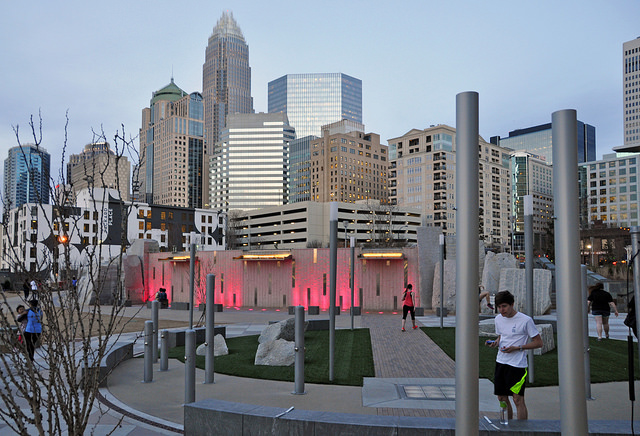
Civic leaders in Charlotte, N.C., share ideas on role of public space
Photo: Charlotte skyline as seen from Romare Bearden Park on S. Church Street. Credit: James Willamor on Flickr.
“Thanks for inviting me to explore a big idea,” said one Charlotte participant, as she left our “city sounding” session with the Municipal Art Society of New York recently.
Knight Foundation is supporting a yearlong exploration about the critical role that civic spaces play in city life, and Charlotte is one of the places where community leaders are sharing thoughts and ideas via these city-sounding sessions.
Earlier this month, more than 30 people gathered in the sunny solarium of Foundation for the Carolinas for the interactive session. It involved role-plays forcing us into new perspectives and scenarios to stretch our thinking about what civic assets might look like in the future.
Mary Rowe, director of urban resilience and livability for the Municipal Art Society, introduced the idea of the civic commons: Where are the shared spaces where connections are made? Are they just in the center city or are they all over the city? And, are they always physical places or can interconnectedness happen on the Internet?
Mary’s team left with lots of sticky notes and facilitator observations, so we don’t yet what insights will resonate and be important to their work. But I was struck by several comments as the morning ended.
From Catherine Horne, the new executive director of Discovery Place: “The city is welcoming and friendly,” she said, but then she suggested we might strengthen ties between people, and between people and Charlotte’s institutions.
Dan Roselli of Packard Place, a hub for entrepreneurship and innovation Uptown, offered this observation: This has been a city of builders, he said, and that has made Charlotte the successful city that it is. But, maybe he added, it’s time for more farmers, who will till the soil and make it more likely that entrepreneurial seeds can grow.
Architect David Furman added to that organic theme. The public realm, as he sees it, is about sidewalks, streets, things we engage with every day. Our challenge, he said, is to design places where diverse life experiences can thrive, where things can spring up organically.
Our participants – ranging from City Planning Director Debra Campbell to Gantt Huberman architect Cathy Morrison – were fully engaged in the discussion, and for that I’m appreciative. Like them, I’ll be eager to see what ideas and recommendations will come out of the project’s research and other city soundings.
Susan Patterson is Charlotte program director at Knight Foundation.
Recent Content
-
Community Impactarticle ·
-
Community Impactarticle ·
-
Community Impactarticle ·


